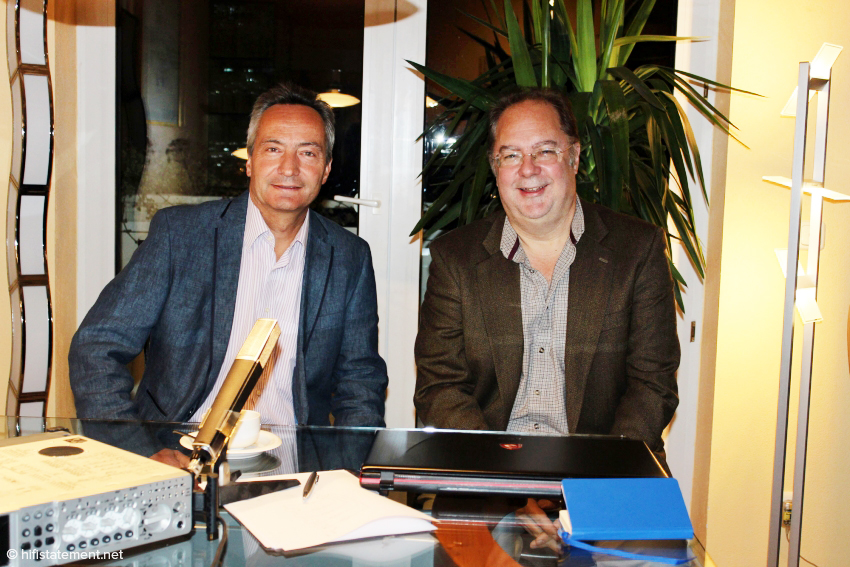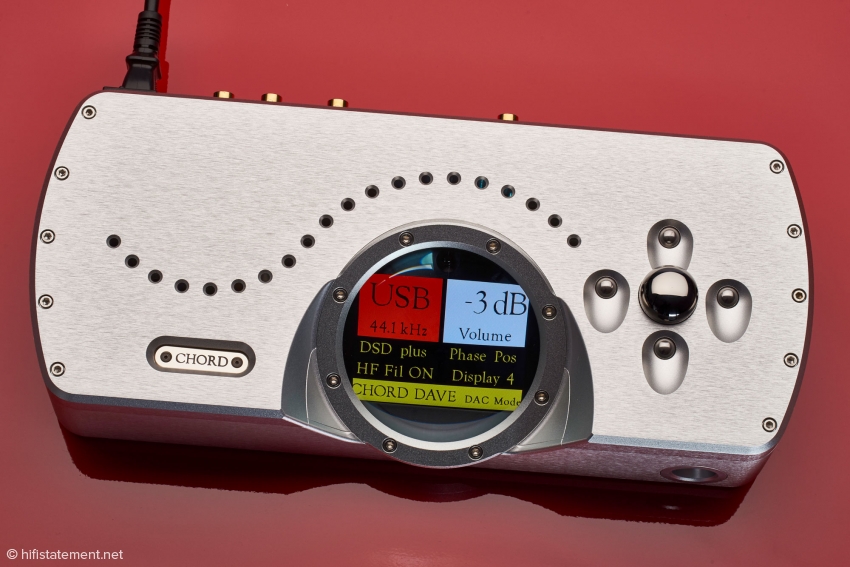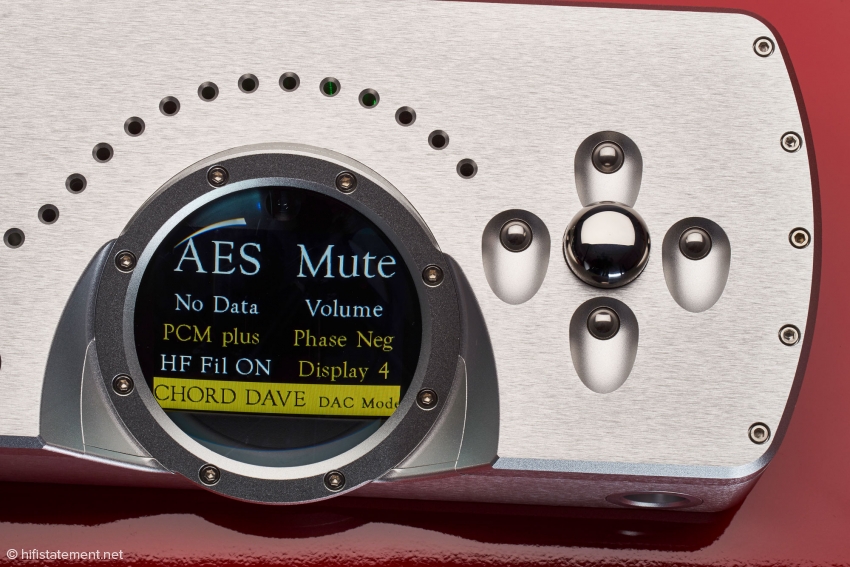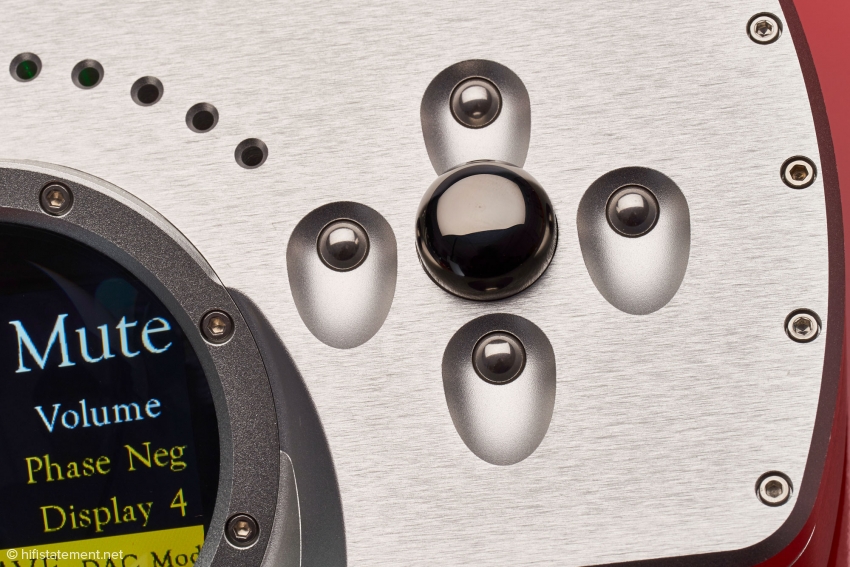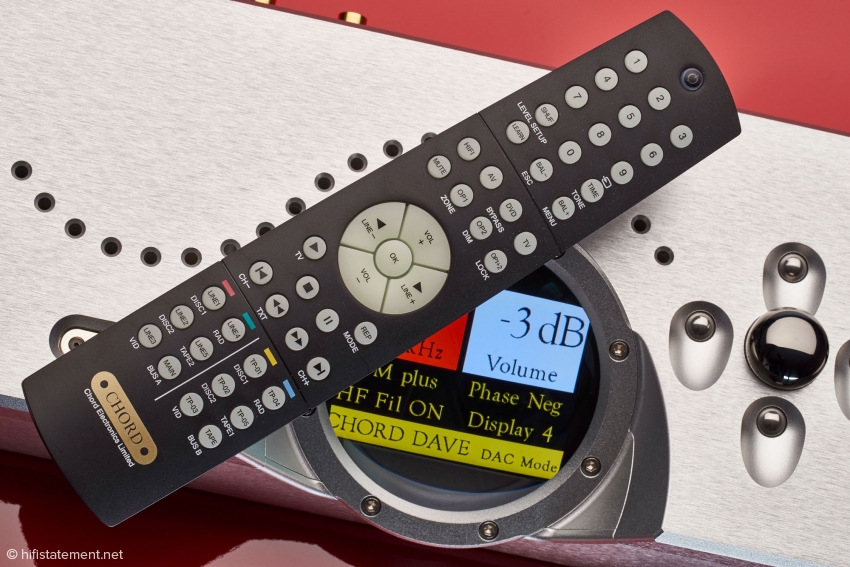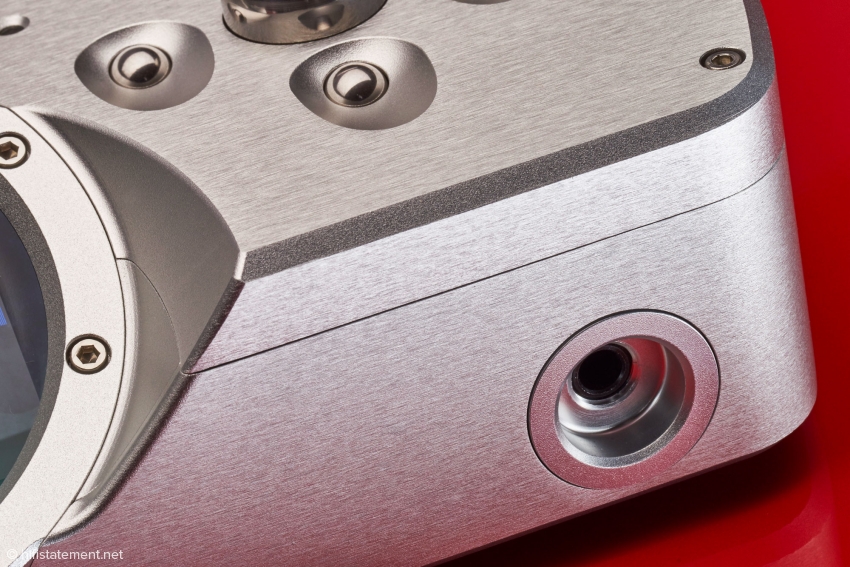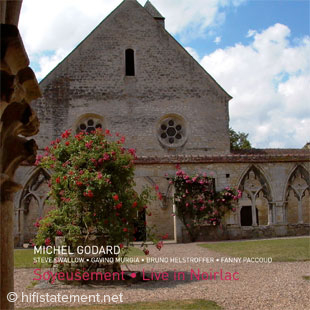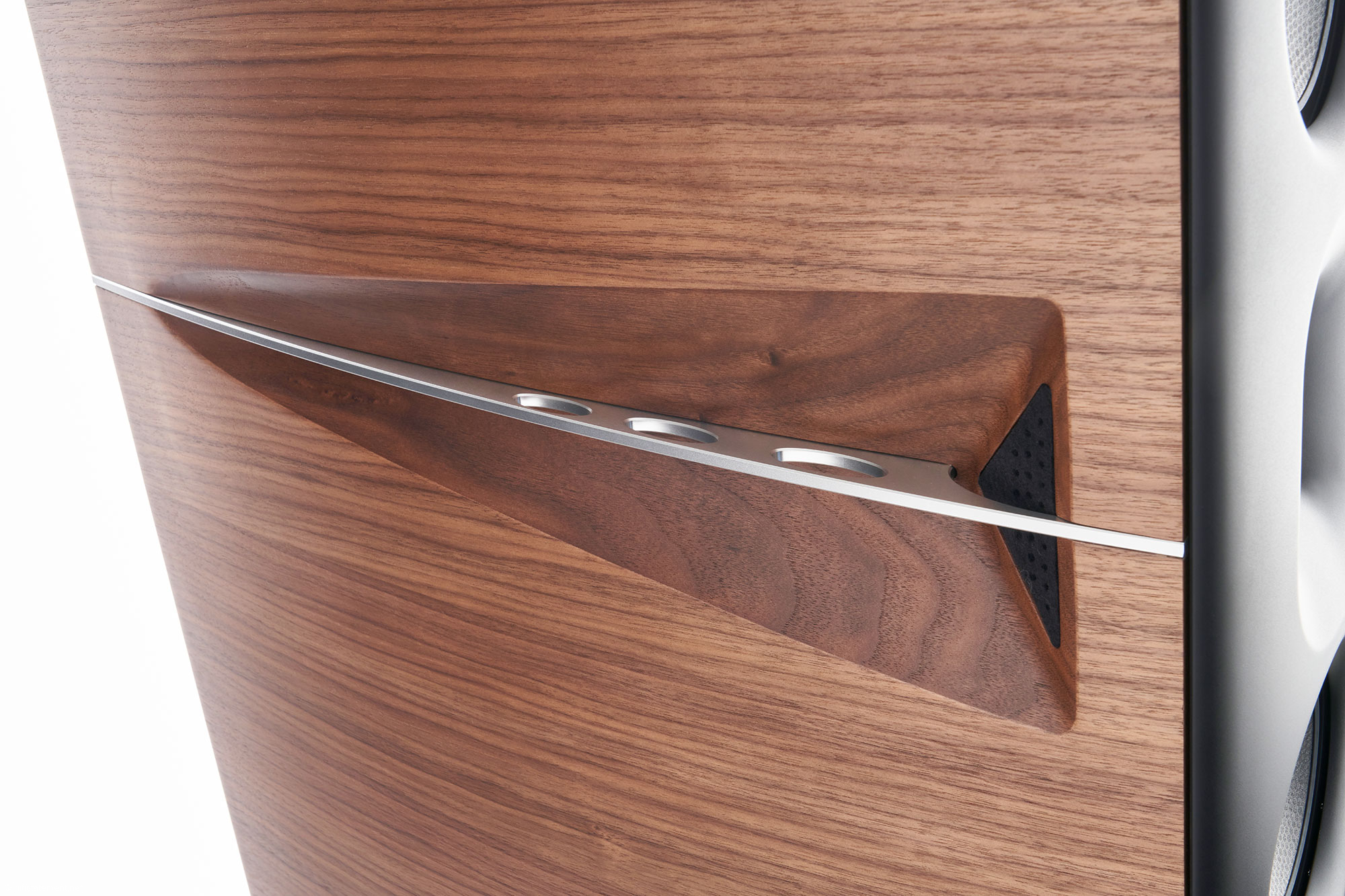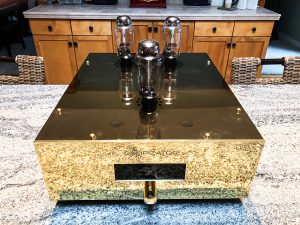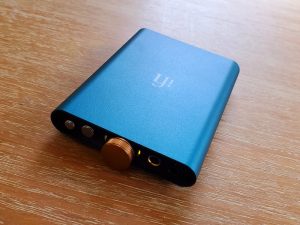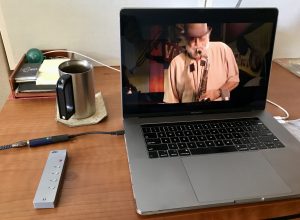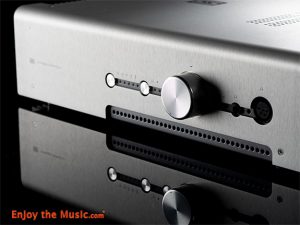As reported in the News Section of HiFi Statement, I didn't have much chance to listen to some music when developer Rob Watts visited me with the Chord DAVE. But fortunately, I didn't have to wait too long for a second chance, as I could pick up the first DAVE available in Germany in the AUDITORIUM store in Hamm.
This happened two days before Christmas, and hundreds of miles away from my private listening room. And, rather understandably, Leonhard Schwarte of German distributor G8 & Friends wanted to have the device back soon in order to familiarize himself with it. So the time DAVE could spend in my home in Gröbenzell was very limited, and there was another problem. Leonhard had put a large blue sticker of his favorite soccer team on the box! I grew up in the same area but that does not necessarily mean I share Leonhard's preferences when it comes to soccer. Quite on the contrary. But if I wanted to take advantage of the opportunity to be the first in Germany to test the DAVE I had to swallow my pride …
Typical for Chord: The unique design goes hand in hand with perfect craftsmanship
As we've come to expect from Chord, the DAVE's casing is made from solid Aluminum and completely ignores design conventions other manufacturers adhere to. And there's the inevitable 'porthole,' too, located in the middle of the device and slightly angled. But contrary to other Chord products, the porthole here doesn't offer insights into the DAC's interior but instead houses a color display. This informs the user about the active input, the sampling frequency of the incoming signal and the current volume level. Three of the four available layout options also use colors to visualize sampling rate and volume, much like other Chord DACs as the Mojo, Hugo, and Hugo TT do. Another block of information show whether the DAVE is working in PCM or DSD optimized mode. Both formats can be transcoded into each other on the fly, but there is a huge benefit in sound quality when DAVE is set to the mode that matches the actual input format. The current absolute phase is also shown here, as is information about the state of the integrated high frequency filter (can be activated to protect components further down the chain) and which display layout option is currently active.
The third block of information in the display shows the make and name of the DAC and the current operation mode. Because of its integrated lossless digital volume control, DAVE can be used as a digital preamp or as a pure DAC with fixed output level. In addition, when a headphone is plugged into the jack at the front, all other outputs are automatically muted and the DAVE works as a headphone DAC/amp combination. The device always 'remembers' the last volume level set for each mode. When used with headphones, DAVE can drive loads between 8 and 800 Ohms, so it is likely that there are no headphones in existence that will pose any problem for the Chord. All options can be set either using the supplied remote control, or via the four buttons surrounding the rather striking volume control knob. Generally speaking, operation is simple and intuitive, although the special 'two-finger push' needed to switch to DAC mode might require a look into the manual. Everything feels very solid and there's nothing left to wish for in terms of build quality. The only small complaint I have is that using a font without serifs for the display readouts might increase readability and would in my opinion better suit the DAVE's otherwise perfect looks.
DAVE's display shows all important information
If you've read about a Chord DAC before, then you'll know that Rob Watts follows his own way when designing a DAC. He is not using one of the commonly available ready-made DAC chips, but instead programs his own algorithms into a Field Programmable Gate Array (FPGA), even in the small and affordable mobile DAC Mojo. During his visit in Gröbenzell, Rob shared so much information about that with fellow staffer Roland Dietl and me that this warrants a separate article. (This will be published elsewhere in this issue of Positive Feedback very shortly.) For now, without further ado, we'll jump right into describing the sonic performance of the new 'big' Chord.
Immediately after returning home, I hooked up the DAVE with the AURALiC ARIES Femto via USB, with power and with the balanced input of my Einstein amp. I let it run continuously for 48 hours before using it in some experiments that would result in the redecoration of my listening room. Since the arrival of the Melco NAS, my trusted iMac is no longer needed as storage and source for my digital music files. So at first I tried to find out which influence its position between the loudspeakers, in front of the cd shelf at the back wall, had on the sound in my room. With the iMac removed, I realized it had noticeably limited the perceived depth of the imaginary stage, and even the width of the stage benefited from removing it from the room. Now, and also thanks to the DAVE, I can now enjoy an exquisitely vivid and three-dimensional musical experience with the right recordings.
The striking polished volume knob and the four surrounding buttons make selecting the in/out and navigation in the clearly arranged user menu simple and easy.
When a friend visited later I went back to using the Chord Hugo TT which—as you might have noticed—for a while was for me the reference in terms of DACs. I'm happy to report that both Chord devices share the same character in sound, but with DAVE it's simply a little more of everything. More spaciousness in the (imaginary?) room, more and better defined colors, more 'black' in quiet parts of the music, more punch when needed, and more dynamic range. But importantly, none of these aspects are dominant at all, and when compared to his larger sibling, the Hugo TT, by no means feels flawed in any way. The DAVE's performance is very similar to that of the Hugo TT, as mentioned before, but just elevated to an even higher level. A level that's very hard to leave again once you've been there. So I made the most of the short time I had before the DAVE had to be moved into the photo studio and then sent back and went on a search for forgotten gems in my collection of, by now, 1,500 albums on hard disk.
I own the Reference Recording vinyl as well as the RYCO CD edition of Airto Moreiras' Däfos, and have used the percussion spectacle that is "The Gates of Däfos" many times to assess the dynamic abilities of products. But this time I sat down and listened to the entire album from beginning to end. And it was immediately obvious that the DAVE's speed and spaciousness are extraordinary. Especially impressive—and surprising—was the track "Psychopomp." This track uses a unique instrument, made of an aluminum pipe and the bass strings of a grand piano, complemented by a pick-up, volume pedal, and a large subwoofer, and filled my listening room with low frequency energy like never before. This made me curious and I switched back to the Hugo TT, which manages to keep most of the recording's depth but loses a little in width. But the furious deep growl of the instrument, boosted by huge amounts of controlled feedback noise, had lost some of its terrifying nature. This effect is hard to describe in the usual hi-fi terms, but the Hugo TT does not manage to achieve quite the same emotional impact as the DAVE. The big Chord just gives you a little more goosebumps. Needless to say, I wasn't even tempted to try the vinyl in comparison.
All options can also be set using the supplied remote control
While I was still trying to find words for what I just had heard the track "The Gates of Däfos" had started, still through the Hugo TT, and it sounded as dynamic as I seem to remember it from the LP. The sound stage is good, but by no means spectacular. That changed, though, when I went back to the DAVE. The reverberations of every single drum beat were clearly audible and the metallic sounds in the track's second part had more color to it. The big bang after two minutes was much more impressive because the pause before was of a 'deeper' silence. There's no other way of saying it: The Dave simply is in a league of its own.
Never before have I heard my CDs or my digital music files in such good quality. This is true when judged by the usual hi-fi standards but, more importantly, it is also true when judged by the music's emotional impact. Because the DAVE merges fantastic accomplishments in the various areas into an absolutely coherent overall performance, it manages to bring out the touching emotional qualities of music. Depending on the track, music will be more relaxing, more engaging or more dramatic than before. The times that we would accuse digital music of lacking 'soul' are long gone by now, fortunately. And with the DAVE digital music now achieves a completely new level of intensity. And it does so without any flamboyancy, just by doing everything right.
When headphones are plugged in the DAVE automatically changes into headphone mode and mutes the RCA and XLR outputs.
STATEMENT
The Chord DAVE is a truly extraordinary DAC. That is of course due to the technology used, which we will talk about in Part 2 of this article. But it is its ability to bring out the emotional qualities of music in a way I have never experienced before that makes it stand out. For me, DAVE is simply a DAC dream come true.
LISTENED TO WITH
- NAS: Melco HA-N1A, WDMyCloud
- Wireless Streaming Bridge: Auralic Aries Femto with SBooster BOTW P&P Eco and SBooster Ultra
- Network Player: Ayon S-3
- D/A Converter: Chord Hugo TT
- Preamplifier: Einstein The Preamp
- Power Amplifier: Ayon Epsilon with KT150
- Loudspeakers: LumenWhite DiamondLight Monitors
- Cables: HMS Gran Finale Jubilee, Audioplan, Powercord S, Göbel High End Lacorde Statement, Audioquest, Cinnamon, Carbon, Wild and Diamond, Swiss Cable Reference Plus.
- Accessories: PS Power Plant, Sun Leiste, Audioplan Powerstar, HMS wall outlets, Audioquest Jitterbug, SOtM iSO-CAT6, Acapella bases, Acoustic System feet and resonators, Artesania Audio Exoteryc, Harmonix Real Focus, bfly bases and feet.
Specifications (by the manufacturer)
- Maximum output voltage: 6 volts RMS
- THD and noise at 2.5 volts: RMS 0.000015 %
- THD and noise at 2.5 volts: 127dBA Awt (124dBA into 33 ohms)
- Dynamic range at -60 dBFS 1kHz -127 dBA A wt
- (No measurable noise floor modulation, no a harmonic distortion)
- (Analogue distortion characteristic: no distortion for small signals)
- Power requirements: mains power 80 volts to 260 volts; AC 20 watts
Inputs:
- USB B-style: 44 kHz to 768 kHz - DXD and Quad DSD
- 2x optical: 44kHz to 192kHz
- 1 x AES: 44kHz to 192kHz
- 4 x Coax: 44kHz to 384kHz
- Dual-data mode available
Outputs digital:
- 2x ultra-high-speed coax 768kHz dual-data mode for use with future-unannounced Chord Electronics products.
US Distributor
Bluebird Music
416-638-8207
http://www.bluebirdmusic.com/contact.html




